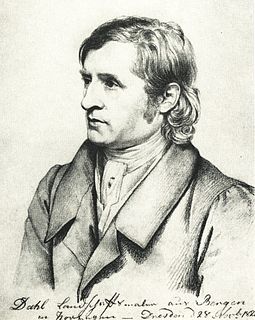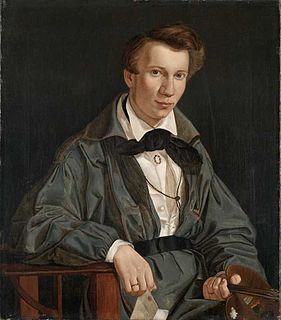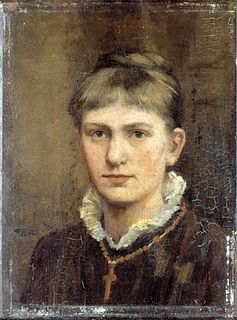
Peter Vilhelm Carl Kyhn was a Danish landscape painter who belonged to the generation of national romantic painters immediately after the Danish Golden Age and before the Modern Breakthrough. Even though he outlived many of his artistic peers by several decades, he remained a traditionalist and expressed strong criticism of many of the new trends in the painting of his day.

Johan Christian Claussen Dahl, often known as J. C. Dahl or I. C. Dahl, was a Norwegian artist who is considered the first great romantic painter in Norway, the founder of the "golden age" of Norwegian painting, and, by some, one of the greatest European artists of all time. He is often described as "the father of Norwegian landscape painting" and is regarded as the first Norwegian painter to reach a level of artistic accomplishment comparable to that attained by the greatest European artists of his day. He was also the first to acquire genuine fame and cultural renown abroad. As one critic has put it, "J.C. Dahl occupies a central position in Norwegian artistic life of the first half of the 19th century.

Carl Frederik von Breda was a Swedish painter who studied in and spent much of his career in Britain before becoming painter to the Swedish court. He was born in Stockholm in 1759, and moved to Britain where he was a student of Joshua Reynolds. Breda specialized in painting portraits and was called "the van Dyck of Sweden". He returned to Sweden 1796 where he became Professor at the Academy of Arts, a popular portraitist, and a court painter. Breda married at age 22 and his son, Johan Fredrik, was also a painter, who studied under his father. Breda died in Stockholm in 1818. Breda painted James Watt.

Pehr Hilleström was a Swedish artist. He served as a professor and director at the Royal Swedish Academy of Arts.

For much of its history Norwegian art is usually considered as part of the wider Nordic art of Scandinavia. It has, especially since about 1100, been strongly influenced by wider trends in European art. After World War II, the influence of the United States strengthened substantially. Due to generous art subsidies, contemporary Norwegian art has a high production per capita.

Hjalmar Eilif Emanuel Peterssen was a Norwegian painter. He is most commonly associated with his landscapes and portraits.

Robert Thegerström was a Swedish painter and graphic artist.

Kilian Christoffer Zoll was a Swedish painter, graphic artist and illustrator in the style of the Düsseldorf School. He created genre scenes, landscapes, altarpieces and portraits.

Knud Baade was a Norwegian painter, mostly of portraits and landscapes. He was particularly known for his moonlight paintings which are characterized by strong and dramatic contrasts between light and shadow.

Oscar Gustaf Björck was a Swedish painter and a professor at the Royal Swedish Academy of Arts.

Thomas Fearnley was a Norwegian romantic painter, a pupil of Johan Christian Dahl and a leading representative of Norwegian romantic nationalism in painting. His son Thomas Fearnley (1841–1927) founded the Fearnley dynasty of shipping magnates.

David Sigurd Wallin was a Swedish artist. He grew up in Stockholm.

Egron Sellif Lundgren was a Swedish painter and author who specialized in watercolors.

Aleksander Lauréus, also Alexander Lauraeus, was a Finnish painter.

Joachim Christian Geelmuyden Gyldenkrantz Frich was a Norwegian landscape painter. He was associated with the Düsseldorf school of painting (Düsseldorf-skolen).

Axel Wilhelm Nordgren was a Swedish landscape painter.

Hugo Fredrik Salmson was a Swedish painter; known for figures and genre scenes.

Johan Per Södermark was a Swedish military officer, painter and lithographer.

Carl Wilhelm Nordgren was a Swedish portrait painter and professional trumpeter, for the Life Guards of Horse.

Cecilie Dahl (1858–1943) was a Norwegian artist who painted portraits, genre paintings and landscapes. From the early 1880s, she exhibited at the Oslo Kunstforening and in 1888 presented a work inspired by Henrik Ibsen's Brand at the Nordic Exhibition in Copenhagen. Her best works are those of women and children from the mid-1890s, characterized by a soft, rather melancholy atmosphere. She was inspired by evening scenes, as in Augustkveld, Hakadal in the collection of the Norwegian National Gallery.





















